Reading this post via email or mobile version?
Want to read comments or enter your own? Want to see posts from other years or
even previous posts from this year? Just click on the post title to access our
full web page.
As we passed the Ararat Brandy Company at the beginning of another day trip exploring more of Armenia, Nelli, our tour guide with Envoy Hostel, mentioned that Winston Churchill loved the Armenian brandy so much that Stalin sent him 400 bottles of it a year after they met in Yalta! A few minutes later, Steven and I were surprised to catch a view of the US' largest embassy in the world after Iraq. Neither of us could understand why the US had such a huge diplomatic presence in Armenia.
Close to the city was St. Hripsme Church, built in 618 AD and therefore one of the oldest churches in Armenia. Nelli didn't specify whether any special celebrations will be held to mark its 1400th anniversary this year. UNESCO has listed the church, constructed of tuff stone and including a 16-sided drum tower, as a World Heritage site since 2000.
The church was built above a mausoleum dedicated to the first martyrs of Armenia, St. Hripsme, and other nuns who fled from Rome to Armenia after she rejected the unwanted attentions of Diocletian. When the beautiful woman also refused the advances of the pagan King Trdat III, she and the others were stoned to death. Trdat later converted to Christianity so the story does have a happy ending at least!
The stone in the small chapel honoring St. Hripsme was added in the 19th century.
St. Gayane and 37 other nuns were also stoned to death because of their faith. In 301 AD, Armenia adopted Christianity and therefore became the first country to do so, something I was never aware of previously.
Before St. Gayane died, her last words were the words to this prayer.
Nelli revealed that Pope Francis preached here just inside the entrance at the Mother See when he visited Yerevan even though she stressed there is no connection between the Roman Catholic and Armenian Apostolic churches.
In the complex was the seminary where the priests lived.
These were copies of the two largest cross stones or khachars and were constructed of marble which was very unusual. The originals were in Turkey.
One of the most notable contemporary churches in the compound was the Holy Archangels Church with its unusual umbrella roof.
In the gardens was the first Armenian Genocide Memorial to honor those killed by the Turks from 1915-23. It was only constructed fifty years later after Stalin had died because it was forbidden to talk about what had happened while he was alive. The memorial contained the Armenian national bird, the eagle, at the top and, at the bottom, the tree of life that represented Armenia still survived as a nation even though they had 'lost' 1.5 million of its people.
As we walked back toward the entrance, Nelli told us the Holy See also contained the Palace of the Catholicos, the home of the current supreme prelate of the 1700-year-old Armenian Apostolic faith. I have never been fortunate to visit Rome and the Vatican but the size and magnitude of the Holy See was pretty overwhelming and deserved more time than we had there.


In the village of Khor Virap we were treated to a superb lunch at the home of Harut, an artist, architect and farmer, and his wife. Harut was holding lavash, an Armenian bread similar to a pita.
These were just some of the Armenian dishes we were treated to that day! Again, there was no chance of anyone leaving the table hungry after we dined on salads, zucchini fritters, dolmades, two dishes with eggplant and mashed potatoes all superbly cooked by Harut's wife, Armine!
Nelli indicated that Envoy Hostel in Yerevan had been working with Harut and Armine for ten years for them to provide lunch to its tour groups when visiting Khor Virap. Judging from our experience, Envoy had chosen well!
Later Harut kindly showed me his garden and impressive farm while Nelli translated for me.
Harut said his pregnant pig would soon again have 15 piglets but he would keep just tree of them.
So much of the food we'd just eaten had come from his organic garden: cucumbers, different types of peppers, tomatoes, etc.
I don't know why only I was the lucky one to be treated to his delicious figs he plucked from the tree for me to eat right away! After eating so much a few minutes ago, I only had room for a couple figs although Harut wanted to treat me to many more.
I love this photo of Harut and Nelli and already miss their exceptional kindness to a visitor to their country.
The pomegranates wouldn't be ready for a while yet, Harut explained.
The late afternoon was the perfect time to reach the monastery at Noravank that was was built in the 13th and 14th centuries because the reddish hues on the surrounding cliffs and the reddish-gold stone of its churches was extraordinarily beautiful.
The Mongolian influence on the depiction of Jesus was very evident on this carving above the doorway at the 13th century Surp Karapet Church.
At the 14th century St. John the Baptist Church, neither Steven nor I wanted take any chances slipping on the narrowest stairs I remember seeing but we enjoyed watching other people going up and down!
Instead, I was content to walk inside the chapel at the base.
A shot of Steven looking into the chapel:
The final treat of the day was stopping at Hin Areni Wine Factory where we each had four different wine tastings made from using their red Areni and golden seed grapes. Only one of the reds was one we would have considered buying if we weren't so far from home. Will: I would have been interested in knowing your views since you have a far more sophisticated palate than we do.
As we passed the Ararat Brandy Company at the beginning of another day trip exploring more of Armenia, Nelli, our tour guide with Envoy Hostel, mentioned that Winston Churchill loved the Armenian brandy so much that Stalin sent him 400 bottles of it a year after they met in Yalta! A few minutes later, Steven and I were surprised to catch a view of the US' largest embassy in the world after Iraq. Neither of us could understand why the US had such a huge diplomatic presence in Armenia.
Close to the city was St. Hripsme Church, built in 618 AD and therefore one of the oldest churches in Armenia. Nelli didn't specify whether any special celebrations will be held to mark its 1400th anniversary this year. UNESCO has listed the church, constructed of tuff stone and including a 16-sided drum tower, as a World Heritage site since 2000.
The church was built above a mausoleum dedicated to the first martyrs of Armenia, St. Hripsme, and other nuns who fled from Rome to Armenia after she rejected the unwanted attentions of Diocletian. When the beautiful woman also refused the advances of the pagan King Trdat III, she and the others were stoned to death. Trdat later converted to Christianity so the story does have a happy ending at least!
The 7th century St. Gayane Monastery was the only place in Armenia where nuns live and study. Nelli didn't indicate what will happen to the monastery when the only two remaining nuns die.
The fresco above the entrance to the church was added in the 19th century.
As with some other Armenian churches, the church had three naves and was compared with Noah's ark: the stone floor in the first area represented Noah's family; the second, carpeted area was for the Armenian family and Noah's animals; the third was the altar which was for priests only and represented the birds in the ark who were closest to God.St. Gayane and 37 other nuns were also stoned to death because of their faith. In 301 AD, Armenia adopted Christianity and therefore became the first country to do so, something I was never aware of previously.
Before St. Gayane died, her last words were the words to this prayer.
The Mother See of Holy Echmiadzin, the equivalent to the Vatican of the Armenian Apostolic Church, was the place where St. George the Illuminator saw a beam of light fall to the earth in a divine vision and subsequently built the first Mayr Tachar or Mother Church. The cathedral compound and the surrounding settlement was the de facto capital of Armenia from 180 to 340.
The entrance to the huge religious complex showed King Trdat and St. Gregory embracing the cross which represented Armenia's adoption of Christianity.Nelli revealed that Pope Francis preached here just inside the entrance at the Mother See when he visited Yerevan even though she stressed there is no connection between the Roman Catholic and Armenian Apostolic churches.
In the complex was the seminary where the priests lived.
These were copies of the two largest cross stones or khachars and were constructed of marble which was very unusual. The originals were in Turkey.
One of the most notable contemporary churches in the compound was the Holy Archangels Church with its unusual umbrella roof.
The main cathedral, Mayr Tachar, stood in a quadrangle surrounded by gardens and 19th century buildings. The exterior of the church, which was consecrated in 303 and later rebuilt after falling into ruin, was undergoing a major restoration as it had in the 600s, 1600s and 1700s.
Nelli told us that the lovely ceiling frescoes contained all natural colors.
As we walked back toward the entrance, Nelli told us the Holy See also contained the Palace of the Catholicos, the home of the current supreme prelate of the 1700-year-old Armenian Apostolic faith. I have never been fortunate to visit Rome and the Vatican but the size and magnitude of the Holy See was pretty overwhelming and deserved more time than we had there.
The preceding places were all located west of Yerevan. The tour took us south of the capital next to Khor Virap Monastery whose buildings have been repeatedly rebuilt since the 6th century. The monastery, known as Deep Dungeon, is home to one of Armenia's major pilgrimage sites.
The main Surp (or St.) Astvatsatsin Church dated from the 17th century. According to legend, after pagan King Trdat III imprisoned St. Gregory the Illuminator here for about 12 years, the king was driven mad or sprouted the head of a boar depending on what you believe! It was only after St. Gregory miraculously cured the king that he converted to Christianity and St. Gregory then became the first Catholicos of the Armenian Apostolic Church.
To the right of the altar was a long line of pilgrims and tourists waiting to climb down an incredibly steep and narrow space on a ladder into the well where the saint was incarcerated. Steven had a bad ankle so he thought it'd be best not to attempt to climb down. I tried to go down but chickened out initially because of the gap to reach the first rung and then the gap between the vertical rungs. I finally got up my nerve and, sweating so profusely because of the confined space and the difficulty reaching each rung I thought my glasses might fall right off, I got to the bottom!
The well was so tiny only a few people could fit in the enclosed space that I hated to think of anyone having a panic attack on the ladder or at the bottom. There was a long line of people wanting to come down and no one was monitoring how many were already at the bottom or to allow those there to climb back up.
The poster on the cell's wall was of events in the life of the saint and king, including the king being depicted with the boar's head.
Nelli kindly took the picture of three of us on the tour ascending the ladder. I look far happier then than I did going down, let me tell you!
Coming up for air again once at the top!
The monastery and village of the same name are at the foot of 5137 meter high Mt. Ararat in Turkey, rarely visible in the distance sadly because of pollution. Nelli told us there's always snow at the top, even in summer. When we looked closely, we could see a mosque's minarets in the distance, i.e.in Turkey across a river that divided the two countries. The Ararat Valley on the Armenian side was an extremely fertile area, producing apricots especially, according to Nelli.
The charming and engaging Nelli took this selfie of our tour group as we walked back to the monastery after climbing up the hill for views of Mt. Ararat. As with the last tour, everyone on the tour got on so well and it was so much fun spending the day with the couples from Germany, Canada and Peru, and the Philippines from left to right below. The Italian-Thai couple who were on the ladder with me somehow didn't make it into the group photo unfortunately! Never before had we met so many other couples on a day trip who had also met their loved ones while traveling as Steven and I did!
These were just some of the Armenian dishes we were treated to that day! Again, there was no chance of anyone leaving the table hungry after we dined on salads, zucchini fritters, dolmades, two dishes with eggplant and mashed potatoes all superbly cooked by Harut's wife, Armine!
Nelli indicated that Envoy Hostel in Yerevan had been working with Harut and Armine for ten years for them to provide lunch to its tour groups when visiting Khor Virap. Judging from our experience, Envoy had chosen well!
Later Harut kindly showed me his garden and impressive farm while Nelli translated for me.
Harut said his pregnant pig would soon again have 15 piglets but he would keep just tree of them.
So much of the food we'd just eaten had come from his organic garden: cucumbers, different types of peppers, tomatoes, etc.
I don't know why only I was the lucky one to be treated to his delicious figs he plucked from the tree for me to eat right away! After eating so much a few minutes ago, I only had room for a couple figs although Harut wanted to treat me to many more.
I love this photo of Harut and Nelli and already miss their exceptional kindness to a visitor to their country.
The pomegranates wouldn't be ready for a while yet, Harut explained.
While we enjoyed tea, fruit and candies on the patio, Harut showed us a map of how large Armenia had once been before neighboring countries had taken away so much of their land. It was sad to know what that meant to Harut, his family and their countrymen.
On the two hour journey to Noravank, aka the New Monastery, we drove through pretty mountainous terrain and passed countless roadside fruit stands.The late afternoon was the perfect time to reach the monastery at Noravank that was was built in the 13th and 14th centuries because the reddish hues on the surrounding cliffs and the reddish-gold stone of its churches was extraordinarily beautiful.
To enter the church, we could only walk over tombstones directly in front which meant we were taking away the sins of the departed. I can't imagine they now had any sins left with all the thousands of people that have walked over the same stones!
The crosses on the exterior walls represented those who were buried in the church.
It was so special seeing a wedding take place at Surp Karapet as it reminded us that three of our four children got married within the last ten months all over the US, the most recently just two weeks before we left on this trip!At the 14th century St. John the Baptist Church, neither Steven nor I wanted take any chances slipping on the narrowest stairs I remember seeing but we enjoyed watching other people going up and down!
En route to our last stop, Nelli pointed out the cave where the world's oldest shoe had been found and that we'd been lucky enough to see, if not able to take a photo of (boo hiss!), at the History Museum of Armenia.
Because of the climatic extremes in Armenia, few grape varieties thrive but the valleys around the village of Areni have been a quality wine-growing area for over 6,000 years, according to Lonely Planet. I didn't realize initially that the roadside stands were selling bottles of wine rather than cola so that Iranian truck drivers could smuggle the camouflaged vino over the border! The final treat of the day was stopping at Hin Areni Wine Factory where we each had four different wine tastings made from using their red Areni and golden seed grapes. Only one of the reds was one we would have considered buying if we weren't so far from home. Will: I would have been interested in knowing your views since you have a far more sophisticated palate than we do.
The day trip had been a fantastic time from beginning to end but we were tired when we returned to Yerevan about ten hours after starting out!
Next post: Visiting the Armenia Genocide Memorial and the National Gallery of Armenia.
Posted on August 27th, 2018, from Tbilisi, Georgia.



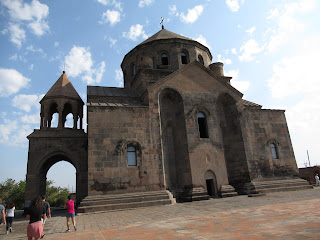






















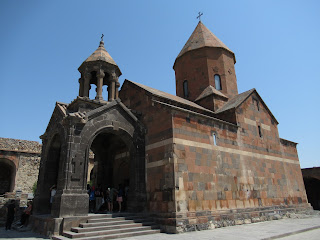










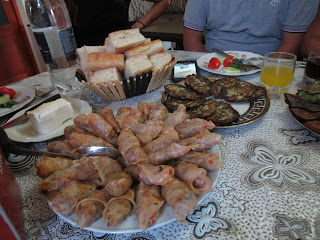
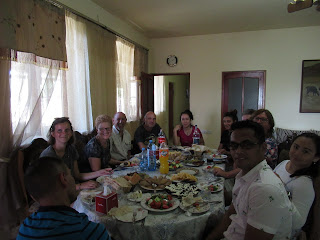

















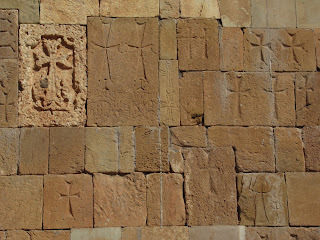











Love the brilliant blue skies, the gardens, the smiles on your Armenian host's faces and of course your smiles which never fade:)
ReplyDeletexo Lina
The colors of the Armenian countryside and its many churches and monasteries WERE an absolute delight as was the kindness and generosity expressed by our host at lunch, Lina. I can't say I was smiling much when climbing down that ladder into St.Gregory's cell, however!
ReplyDelete